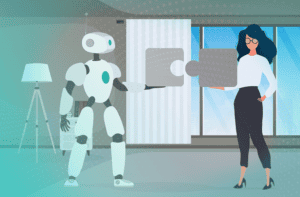I chatbots, or chat assistants, are software programs designed to simulate human conversations through texts or conversations. In recent years, chatbots have become increasingly popular in customer service, as they allow 24/7 responses to users to be provided quickly and inexpensively. However, chatbots still have limitations compared to human operators in terms of understanding natural language and ability to provide personalized responses.
To offer high-quality customer service, companies must strike the right balance between the automation offered by chatbots and the empathy and problem solving provided by human operators. So let’s see when and how best to integrate these two resources.
Chatbots: advantages and limitations
Chatbots are computer programs designed to converse with customers and answer their questions and can be used in a variety of areas, including customer service, marketing, and sales.
One of the main advantages of chatbots is their ability to provide 24/7 customer service without the need for a human operator. In addition, chatbots can answer customer questions quickly and effectively, reducing wait times and increasing customer satisfaction.
However, this tool obviously has limitations as well. Chatbots may have difficulty understanding complex or ambiguous questionsand may provide inadequate or inaccurate answers. Being essentially algorithms, chatbots can lack empathy and understanding of customer feelings, which can be critical in some situations.
When to use chatbots
With this in mind, what then are the most suitable scenarios for their use? Chatbots are particularly good for:
- Answering users’ frequently asked questions, thanks to their 24/7 availability. Indeed, they can quickly provide standard information such as opening hours, addresses, status of an order.
- Perform repetitive tasks that do not require complex reasoning, such as reservations, order changes, product database searches.
- Collect preliminary information from users and then refer them to the most appropriate human operator.
- Provide basic support and troubleshooting, such as for frequent technical problems.
Human operators: advantages and limitations
Dealing with a human operator is obviously an advantage in situations where the complexity of the demands or the difficulty of the moment requires an empathetic and personalized approach. Customer care specialists are often specially trained and have a broad range of knowledge derived from experience.
Limitations remain, however, even in this case: the cost in terms of time and resources is certainly onerous, especially if operators need to be constantly trained to maintain level quality standards. An additional cost depends on availability, which undoubtedly cannot be 24/7. Moreover, operators are as susceptible to errors as and as much as chatbots, as fallible human beings.
The training of human workers
To provide quality customer service, it is important that human operators are properly trained and supported. Customer care specialists must be able to understand the needs of customers and provide personalized, high-level responses, so the range of training must also include the use of effective communication techniques and empathy.
In addition, human operators must be able to work collaboratively with chatbots, monitoring automated conversations and intervening when necessary, such as when the chatbot cannot understand a question or provides an inadequate answer. Training human operators can include the use of artificial intelligence software to improve the efficiency of handling inquiries, answering customer questions more quickly and effectively.
When human operators are needed
Human workers remain indispensable when:
- Advanced natural language understanding, empathy and emotional intelligence is required to handle complex conversations.
- You have to solve problems that require logical reasoning and problem solving skills.
- It is necessary to negotiate or make exceptions to company policies to satisfy the customer.
- One has to handle complaints, grievances or angry customers. Human workers can calm tempers.
- You want to create a personalized relationship of trust with the customer, which is important for retention.

How to strike the right balance between chatbots and human operators
Chatbots can be a great way to provide fast and effective customer service, but they cannot completely replace human operators. To provide quality customer service and efficiently handle a high volume of inquiries, the best solution is to combine chatbots and human operators strategically, leveraging the strengths of both. Integration between the two resources is critical for a seamless, omnichannel customer journey. Based on the characteristics, it is obvious that integrating the two requires specific analysis of the various tasks so as to create efficient customer service with high standards of care. While chatbots can handle the repetitive or simpler parts of assistance, or be the first contact with the user before triaging the request to the most qualified operator, human operators must focus on more complex and communication-impacting problems.
How to integrate chatbots and operators
To take advantage of both resources, it is important to integrate chatbots and human operators strategically:
- Chatbot as the first level of assistance
Chatbots can filter and handle the simplest requests, solving the most common problems 24/7 and reducing the workload of operators. They can then act as the “first line” of customer service. - Cross-platform integration
The chatbot’s platform must be seamlessly integrated with the one used by the operators, so that the conversation can move seamlessly from one channel to another and the history is shared. - Identification of complex requests
The chatbot, through the use of keywords and algorithms, must be able to recognize when a request needs human intervention and pass it appropriately to the operator. - Continuous feedback
Operators should notify the chatbot development team when it does not understand a question correctly so that it can continuously improve its natural language capabilities. - Omnichannel customer journey
Chatbots need to be integrated with other customer service channels such as email, social, and live chat to provide an omnichannel user experience.
XCALLY: using AI as a tool to support operators
In this view of useful integration between the reality of automated algorithms and traditional support with customer care specialists, the omnichannel platform of XCALLY may prove to be the perfect tool to create the right balance between the use of chatbots and human operators in a contact center:
- Advanced artificial intelligence for chatbots capable of handling increasingly complex conversations similar to human language. XCALLY’s chatbots understand natural language.
- Automatic detection of user intentions to understand when to forward the conversation to a human operator because the chatbot has reached its limits.
- Advanced reporting to identify instances where chatbots were unable to solve the problem and human intervention was needed. These insights can be used to improve the capabilities of chatbots.
- Integration of chatbots with knowledge base and FAQs to provide quick and consistent answers to common user questions.
- Ability to smoothly transfer conversation from chatbot to human operator and vice versa for a seamless experience.
- Real-time performance monitoring of chatbots and operators to dynamically balance volumes and queues.
- Hand-off functionality between chatbots and agentsto share context and preserve continuity of conversation.
- Training human operators on how to best interact with chatbots and manage handover with the user.
Through these features. XCALLY optimizes the use of human resources and automation for efficient and effective customer service.






